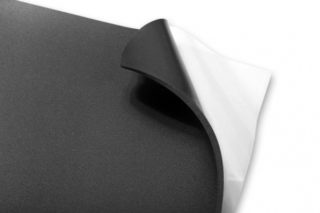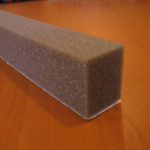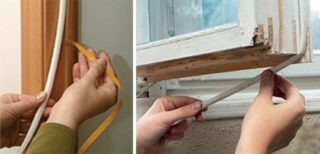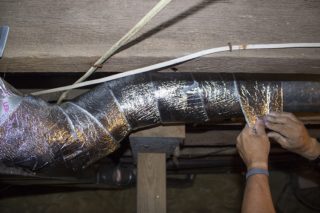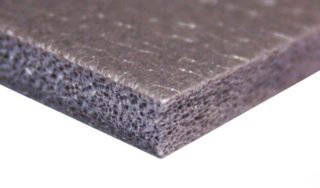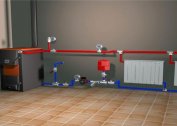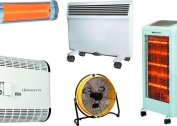Self-adhesive insulation - a material used in construction. With its help, small cracks are closed so that there are no drafts, they seal the surface of windows, walls, and prevent freezing. Its various types are designed to solve certain problems.
The main types of insulation
Foamed polyethylene
The heat insulator has a porous structure, it is very ductile and durable. This material is most often used for soundproofing and insulation. The industry produces three types of foamed polyethylene.
- Unstitched. The structure is the most loose, the material is the least durable, cheap and affordable. It is used more often for the production of packaging containers.
- KhPPE - with chemical firmware. The material is more dense, with small cells, after deformation restores shape.
- FPPE - with physical or radiation firmware. The most expensive, flexible and soft polymer, can quickly restore shape and fit snugly to the surface.
All types of foamed polyethylene are covered with foil, the top layer of which is polished.
Self-adhesive foil insulation does not allow moisture, does not conduct electric current, does not emit harmful chemicals, and retains heat. It is quite cheap, so it comes first in terms of frequency of use.
Tape for insulation
For insulation of window and door openings, adhesive paper tape is used. It used to be replaced with soap and paper. Using tape is much easier to make insulation, since one side has an adhesive layer.
Self-adhesive thermal insulation tape is available in three varieties:
- rubber - used to seal small cracks, withstands temperature extremes from -50 to +70 degrees;
- silicone - more ductile, covers wide slots, resistant to temperature influences;
- vinyl-polyurethane is a more porous material, protects against dust, but is less durable.
Since foil adhesive thermal insulation tape is not always of the required thickness, sometimes foam rubber is placed for better insulation.
Foam insulation
Heat and noise insulation of rooms is done using foam rubber. Due to the porous structure, it is able to quickly contract and again take its shape. The sealant has a wide scope. It is produced most often in rolls or in the form of adhesive-based tapes.
Insulation film
The material has the ability to retain heat and retain sunlight. It is used to darken windows in rooms, heat reflection from batteries, for underfloor heating. This is an excellent vapor barrier for baths and saunas, not subject to corrosion and water.
- Self-adhesive foam tape
- Thermal insulation film for glass
Advantages and disadvantages of self-adhesive insulation
Self-adhesive insulation has the following advantages:
- high-quality protection against noise, dust and draft;
- surface compaction;
- environmental Safety;
- resistance to moisture and fire;
- light weight;
- resistance to various temperatures;
- affordable cost;
- variety of species;
- convenient form of release;
- ease of installation.
This type of thermal insulation has disadvantages:
- quickly fails and requires replacement;
- the adhesive base often dries and does not adhere well to the base;
- some types (foam rubber) have a low resistance to damage;
- requires special care;
- after use, traces of glue are poorly cleaned.
Over time, aluminum foil corrodes and becomes cloudy, its effect weakens. So that the foil coating spoils less from external influences, the insulation is mounted with a small air gap. Even the small distance between the insulation and the surface finish contributes to ventilation and extends the service life.
Application area
The product is used for interior and exterior decoration. Of the features, water resistance, fire resistance, lightness and strength are important. In addition, the material is environmentally friendly, hypoallergenic and does not emit harmful substances.
Due to its technical characteristics and quality, the material is in demand in construction.
It is applied in the following areas:
- floor insulation;
- sealing windows, doors;
- wall protection;
- pipe insulation;
- insulation and noise insulation of car interiors;
- interior decoration of walls and ceilings of baths and saunas;
- thermal insulation of air ducts, ventilation;
- insulation of air conditioners;
- screens behind heating radiators;
- manufacture of insoles for shoes, goods for tourism and sports.
During installation, self-adhesive insulation for walls is laid with the foil side up.
Rating of products from famous brands
Isolon
The material is made of foamed polyethylene. The insulation is made on an adhesive basis with a one-sided foil coating. It is elastic, durable, provides high-quality thermal insulation. Often used for waterproofing basements, foundations, floors, walls, baths. Isolon is great for noise insulation in cars, as well as a material for the manufacture of packaging.
Isolontape
Self-adhesive tapes made of polyethylene foam are available in rolls for insulation and sound insulation of windows and doors. The material is in demand in construction due to its durability, waterproofness, simple installation, and a small percentage of waste. The insulation is well resistant to vibration and shock loads.
Penofol 2000 type C
Penofol is made on the basis of foamed polyethylene, produced in the form of rolls of blue color. On the one hand it is covered with foil, on the other hand - with an adhesive base. Purpose - insulation of ducts, ventilation systems, air conditioners, technical equipment.
A wide range of self-adhesive insulation allows the buyer to choose the most high-quality and suitable material in a particular case. To do this, you need to carefully study the characteristics and features of each type of thermal insulation.
